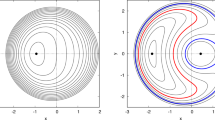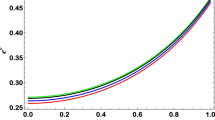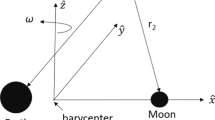Abstract
In this paper, we studied the oblateness and segment-length effect on the dynamics of the restricted 2+2 body problem. It consists of two primaries and two infinitesimal bodies, assuming the bigger primary is an oblate spheroid, and the smaller primary is elongated. The effect of oblateness and segment-length on the equilibrium points are discussed. Variations of equilibrium points of this model compared to the equilibrium points of the classical CRTBP with different parameters are performed. Equilibrium points of some realistic planetary systems, i.e. Jupiter-Amalthea, Pluto-Hydra and Saturn-Prometheus system, are computed. Periodic orbits and their orbital periods are discussed analytically in the Saturn-Prometheus system with binary satellites. Poincaré Surfaces of Section is depicted in the Pluto-Hydra system to elaborate the periodic orbits when the position of one infinitesimal is known.








Similar content being viewed by others
Data availability
The study does not report any data.
References
Yousuf, S., Kishor, R.: Effects of the albedo and disc on the zero velocity curves and linear stability of equilibrium points in the generalized restricted three-body problem. Mon. Not. R. Astron. Soc. 488(2), 1894–1907 (2019)
Ershkov, S., Abouelmagd, E.I., Rachinskaya, A.: A novel type of er3bp introduced for hierarchical configuration with variable angular momentum of secondary planet. Arch. Appl. Mech. 91(11), 4599–4607 (2021)
Ershkov, S., Leshchenko, D., Prosviryakov, E.Y.: A novel type of er3bp introducing Milankovitch cycles or seasonal irradiation processes influencing onto orbit of planet. Arch. Appl. Mech. 93(2), 812–822 (2022)
Ershkov, S., Leshchenko, D., Rachinskaya, A.: Note on the trapped motion in er3bp at the vicinity of barycenter. Arch. Appl. Mech. 91(3), 997–1005 (2021)
Pal, A.K., Abouelmagd, E.I., Kishor, R.: Effect of Moon perturbation on the energy curves and equilibrium points in the Sun-Earth-Moon system. New Astron. 84, 101505 (2021)
Abouelmagd, E.I., Pal, A.K., Guirao, J.L.G.: Analysis of nominal halo orbits in the Sun-Earth system. Arch. Appl. Mech. 91(12), 4751–4763 (2021)
Idrisi, M.J., Ullah, M.S.: Motion around out-of-plane equilibrium points in the frame of restricted six-body problem under radiation pressure. Few-Body Syst. 63(2), 50 (2022)
Bairwa, L.K., Pal, A.K., Kumari, R., Alhowaity, S., Abouelmagd, E.I.: Study of Lagrange Points in the Earth-Moon System with Continuation Fractional Potential. Fractal Fract. 6(6), 321 (2022)
Idrisi, M.J., Eshetie, T., Tilahun, T., Kerebh, M.: Triangular equilibria in R3BP under the consideration of Yukawa correction to Newtonian potential. J. Appl. Math. (2022)
Pal, A., Abouelmagd, E.I.: Dynamical substitutes and energy surfaces in the bicircular sun-earth-moon system. Astron. Lett. 47(5), 331–344 (2021)
Idrisi, M.J., Ullah, M.S.: Central-body square configuration of restricted six-body problem. New Astron. 79, 101381 (2020)
Szebehely, V.: Motion near the equilibrium points. Theory of Orbits
Kishor, R., Kushvah, B.S.: Periodic orbits in the generalized photogravitational chermnykh-like problem with power-law profile. Astrophys. Space Sci. 344(2), 333–346 (2013)
Burgos-García, J., Delgado, J.: Periodic orbits in the restricted four-body problem with two equal masses. Astrophys. Space Sci. 345(2), 247–263 (2013)
Henrard, J., Navarro, J.F.: Families of periodic orbits emanating from homoclinic orbits in the restricted problem of three bodies. Celest. Mech. Dyn. Astron. 89(3), 285–304 (2004)
Kumari, R., Pal, A.K., Bairwa, L.K.: Periodic solution of circular sitnikov restricted four-body problem using multiple scales method. Arch. Appl. Mech. 1–14 (2022)
Idrisi, M.J., Ullah, M.S., Sikkandhar, A.: Effect of perturbations in coriolis and centrifugal forces on libration points in the restricted six-body problem. J. Astronaut. Sci. 68, 4–25 (2021)
Whipple, A.L., Szebehely, V.: The restricted problem of n+ \(\nu \) bodies. Celest. Mech. 32(2), 137–144 (1984)
Whipple, A.L.: Equilibrium solutions of the restricted problem of 2+ 2 bodies. Celest. Mech. 33(3), 271–294 (1984)
Croustalloudi, M.N., Kalvouridis , T.J.: The restricted 2, International Scholarly Research Notices (2013)
Kalvouridis, T., Mavraganis, A.: Equilibria and stability of the restricted photogravitational problem of 2+ 2 bodies. Astrophys. Space Sci. 226(1), 137–148 (1995)
Kalvouridis, T.: Parametric dependence of the stationary solutions in the restricted 2+ 2 body problem. Astrophys. Space Sci. 259(1), 77–90 (1998)
Robe, H.: A new kind of 3-body problem. Celest. Mech. 16(3), 343–351 (1977)
Kaur, B., Aggarwal, R.: Robe’s problem: its extension to 2+ 2 bodies. Astrophys. Space Sci. 339(2), 283–294 (2012)
Kaur, B., Aggarwal, R.: Robe’s restricted problem of 2+ 2 bodies when the bigger primary is a roche ellipsoid. Acta Astronaut. 89, 31–37 (2013)
Kaur, B., Aggarwal, R.: Robe’s restricted problem of 2+ 2 bodies when the bigger primary is a roche ellipsoid and the smaller primary is an oblate body. Astrophys. Space Sci. 349(1), 57–69 (2014)
Aggarwal, R., Kaur, B., Yadav, S.: Robe’s restricted problem of 2+ 2 bodies with a roche ellipsoid-triaxial system. J. Astronaut. Sci. 65(1), 63–81 (2018)
Aggarwal, R., Kaur, B.: Robe’s restricted problem of 2+ 2 bodies with one of the primaries an oblate body. Astrophys. Space Sci. 352(2), 467–479 (2014)
Mahato, G., Pal, A.K., Alhowaity, S., Abouelmagd, E.I., Kushvah, B.S.: Effect of the planetesimal belt on the dynamics of the restricted problem of 2+ 2 bodies. Appl. Sci. 12(1), 424 (2022)
Riaguas, A., Elipe, A., López-Moratalla, T.: Non-linear stability of the equilibria in the gravity field of a finite straight segment. Celest. Mech. Dyn. Astron. 81(3), 235–248 (2001)
Jain, R., Sinha, D.: Stability and regions of motion in the restricted three-body problem when both the primaries are finite straight segments. Astrophys. Space Sci. 351(1), 87–100 (2014)
Jain, R., Sinha, D.: Non-linear stability of l 4 in the restricted problem when the primaries are finite straight segments under resonances. Astrophys. Space Sci. 353(1), 73–88 (2014)
Chauhan, S., Kumar, D., Kaur, B.: Restricted three-body problem under the effect of albedo when smaller primary is a finite straight segment. Appl. Appl. Math. 13(2), 37 (2018)
Mahato, G., Kushvah, B.S., Pal, A.K., Verma, R.K.: Dynamics of the restricted three-body problem having elongated smaller primary with disc-like structure. Adv. Space Res. 69(9), 3490–3501 (2022)
Kumar, D., Aggarwal, R., Kaur, B.: An insight on the restricted problem of 2+ 2 bodies with straight segment. Astron. Nachr. 341(6–7), 669–683 (2020)
Kumar, D., Aggarwal, R., Kaur, B.: On the perturbed restricted 2+ 2 body problem when the primaries are non-spherical. Few-Body Syst. 62(4), 1–18 (2021)
Arredondo, J.A., Guo, J., Stoica, C., Tamayo, C.: On the restricted three body problem with oblate primaries. Astrophys. Space Sci. 341(2), 315–322 (2012)
Suraj, M.S., Mittal, A., Arora, M., Aggarwal, R.: Exploring the fractal basins of convergence in the restricted four-body problem with oblateness. Int. J. Non-Linear Mech. 102, 62–71 (2018)
Kumar, D., Kaur, B., Chauhan, S., Kumar, V.: Robe’s restricted three-body problem when one of the primaries is a finite straight segment. Int. J. Non-Linear Mech. 109, 182–188 (2019)
McCuskey, S.W.: Introduction to celestial mechanics., Reading
Anderson, J.D., Johnson, T.V., Schubert, G., Asmar, S., Jacobson, R.A., Johnston, D., Lau, E.L., Lewis, G., Moore, W.B., Taylor, A., et al.: Amalthea’s density is less than that of water. Science 308(5726), 1291–1293 (2005)
Thomas, P.: Sizes, shapes, and derived properties of the saturnian satellites after the cassini nominal mission. Icarus 208(1), 395–401 (2010)
P. Thomas, J. Burns, L. Rossier, D. Simonelli, J. Veverka, C. Chapman, K. Klaasen, T. Johnson, M. Belton, G. S. S. I. Team: The small inner satellites of jupiter. Icarus 135(1), 360–371 (1998)
Spurgin, G.C.: Periodic orbits in the four body problem with large and small masses. J. Differ. Equ. 249(5), 1131–1144 (2010)
James, J.M.: Celestial Mechanics Notes Set 4: The Circular Restricted Three Body Problem. Florida Atlantic University, Department of Mathematical Sciences
Kumari, R., Kushvah, B.S.: Stability regions of equilibrium points in restricted four-body problem with oblateness effects. Astrophys. Space Sci. 349(2), 693–704 (2014)
Acknowledgements
The first and third author are thankful to DST(SERB) Government of India (Project No.-DST(SERB)/(163)/2016-2017/506/AM). The second author is supported by Enhanced Seed Grant through Endowment Fund Ref: EF/2021-22/QE04-07 from Manipal University Jaipur. The fourth author is financially supported by the Council of Scientific and Industrial Research (CSIR), Govt. of India (File No. 09/085(0126)/2019-EMR-1).
Funding
The authors declare that no funds, grants, or other support were received during the preparation of this manuscript.
Author information
Authors and Affiliations
Contributions
The research in this study was equally contributed by all of the authors.
Corresponding author
Ethics declarations
Conflict of interest
The authors have no relevant financial or non-financial interest to disclose.
Additional information
Publisher's Note
Springer Nature remains neutral with regard to jurisdictional claims in published maps and institutional affiliations.
Appendix 1
Appendix 1
1.1 A.
\(\tau _{17}\) =\(\tau _{27}\) = \(\tau _{37}\) = \(2n^2\),
\(\tau _{16}\) = \(\tau _{26}\) = \(\tau _{36}\) = \(4n^2 - 12n^2\mu \),
\(\tau _{15}\) = \(\tau _{25}\) = \(\tau _{35}\) = \(2n^2 - 2l^2n^2 - 20n^2\mu + 30n^2\mu ^2\),
\(\tau _{14}\) = \(2(1 - \mu ) + 2\mu - 8n^2\mu + 8l^2n^2\mu + 40n^2\mu ^2 - 40n^2\mu ^3\),
\(\tau _{24}\) = \(2(1 - \mu ) - 2\mu - 8n^2\mu + 8l^2n^2\mu + 40n^2\mu ^2 - 40n^2\mu ^3\),
\(\tau _{34}\) = \(-2(1 - \mu ) - 2\mu - 8n^2\mu + 8l^2n^2\mu + 40n^2\mu ^2 - 40n^2\mu ^3\)
\(\tau _{13}\) = \(4(1 - \mu ) - 8 (1 -\mu )\mu - 8\mu ^2 + 12n^2\mu ^2 - 12\,l^2n^2\mu ^2 - 40n^2\mu ^3 + 30n^2\mu ^4\),
\(\tau _{23}\) = \(4(1 - \mu ) - 8(1 - \mu )\mu + 8\mu ^2 + 12n^2\mu ^2 - 12\,l^2n^2\mu ^2 - 40n^2\mu ^3 + 30n^2\mu ^4\),
\(\tau _{33}\) = \(-4(1 - \mu ) + 8(1 - \mu )\mu + 8\mu ^2 + 12n^2\mu ^2 - 12\,l^2n^2\mu ^2 - 40n^2\mu ^3 + 30n^2\mu ^4\),
\(\tau _{12}\) = \(2(1 -\mu ) + 3A(1 - \mu ) - 2\,l^2 (1 - \mu ) - 12(1 - \mu )\mu + 12 (1 - \mu )\mu ^2 + 12\mu ^3 - 8n^2\mu ^3 + 8\,l^2n^2\mu ^3 + 20n^2\mu ^4 - 12n^2\mu ^5\),
\(\tau _{22}\) = \(2(1 - \mu ) + 3A(1 - \mu ) - 2\,l^2 (1 - \mu ) - 12 (1 - \mu )\mu + 12 (1 - \mu )\mu ^2 - 12 \mu ^3 - 8n^2\mu ^3 + 8\,l^2n^2\mu ^3 + 20n^2\mu ^4 - 12n^2\mu ^5\),
\(\tau _{32}\) = \(-2(1 - \mu ) - 3A(1 - \mu ) + 2\,l^2(1 - \mu ) + 12(1 - \mu )\mu - 12(1 - \mu )\mu ^2 - 12\mu ^3 - 8n^2\mu ^3 + 8\,l^2n^2\mu ^3 + 20n^2\mu ^4 - 12n^2\mu ^5\),
\(\tau _{11}\) = \(6A(1 - \mu ) - 4(1 - \mu )\mu - 6A(1 - \mu )\mu + 4\,l^2 (1 - \mu )\mu + 12(1 - \mu )\mu ^2 - 8(1 -\mu )\mu ^3 - 8\mu ^4 + 2n^2\mu ^4 - 2\,l^2n^2 \mu ^4 - 4n^2\mu ^5 + 2n^2\mu ^6\),
\(\tau _{21}\) = \(6A(1 - \mu ) - 4(1 - \mu )\mu - 6A(1 - \mu )\mu + 4\,l^2 (1 - \mu )\mu + 12(1 - \mu )\mu ^2 - 8(1 - \mu )\mu ^3 + 8\mu ^4+ 2n^2\mu ^4 - 2\,l^2n^2\mu ^4 - 4n^2\mu ^5 + 2n^2\mu ^6\),
\(\tau _{31}\) = \(-6A(1 - \mu ) + 4(1 - \mu )\mu + 6A(1 - \mu )\mu - 4\,l^2(1 - \mu )\mu - 12(1 - \mu )\mu ^2 + 8(1 - \mu )\mu ^3 + 8\mu ^4 + 2n^2\mu ^4 - 2\,l^2n^2\mu ^4 - 4n^2\mu ^5 + 2n^2\mu ^6\),
\(\tau _{10}\) = \(3A(1 - \mu ) - 3Al^2 (1 - \mu ) - 6A(1 - \mu )\mu + 2(1 - \mu )\mu ^2 + 3A(1 - \mu )\mu ^2 - 2\,l^2 (1 - \mu )\mu ^2 - 4(1 - \mu )\mu ^3 + 2(1 - \mu )\mu ^4 + 2\mu ^5\),
\(\tau _{20}\) =\(3A(1 - \mu ) - 3Al^2(1 - \mu ) - 6A(1 - \mu )\mu + 2(1 - \mu )\mu ^2 + 3 A(1 - \mu )\mu ^2 - 2\,l^2(1 - \mu )\mu ^2 - 4(1 - \mu )\mu ^3 + 2(1 - \mu )\mu ^4 - 2\mu ^5\),
\(\tau _{30}\) = \(-3A(1 - \mu ) + 3Al^2 (1 - \mu ) + 6A(1 - \mu )\mu - 2(1 - \mu )u^2 - 3A(1 - \mu )\mu ^2 + 2\,l^2 (1 -\mu )\mu ^2 + 4(1 - \mu )\mu ^3 - 2(1 - \mu )\mu ^4 - 2\mu ^5\).
1.2 B.
\(\Phi _1 = 4\left( 4 + l^2\right) \mu ^2 + 4\left( (2 + 3A)(-1 + \mu ) + 2n^2\right) ^2 + \mu \left[ -(2 + 3A)\left( -8 + 19\,l^2\right) (-1 + \mu ) + 2\left( 8 - 24\mu + l^2(-19 + 5\mu )\right) n^2\right] \),
\(\Phi _2 = 4(2 + 3A)^2 (-1 + \mu )^2 -\left\{ -8 \left( 2 + 9 A) + (46 + 87 A) l^2\right) (-1 + \mu ) \mu + 4 \left( 4 - 3\,l^2\right) \right\} \mu ^2 - 8 (-1 + \mu ) \left\{ -4 + 6 \mu + 3 A (-2 + 5 \mu )\right\} n^2 + 4\mu \left( -8 + l^2 (-7 + 10 \mu )\right) n^2 + 16n^4\),
\(\Psi =3\left[ -4 \left( -4 + l^2\right) \mu ^2 + 4 (2 + 5 A) (-1 + \mu ) \left\{ (2 + 3 A) (-1 + \mu ) + 2 n^2\right\} \right. \)\(\left. \quad - \mu \left\{ \left( -8 (2 + 7 A) + (46 + 105 A) l^2\right) (-1 + \mu ) + 2 (8 + 5\,l^2) n^2\right\} \right] \).
Rights and permissions
Springer Nature or its licensor (e.g. a society or other partner) holds exclusive rights to this article under a publishing agreement with the author(s) or other rightsholder(s); author self-archiving of the accepted manuscript version of this article is solely governed by the terms of such publishing agreement and applicable law.
About this article
Cite this article
Verma, R.K., Pal, A.K., Kushvah, B.S. et al. Effect of finite straight segment and oblateness in the restricted 2+2 body problem. Arch Appl Mech 93, 2813–2829 (2023). https://doi.org/10.1007/s00419-023-02409-0
Received:
Accepted:
Published:
Issue Date:
DOI: https://doi.org/10.1007/s00419-023-02409-0




